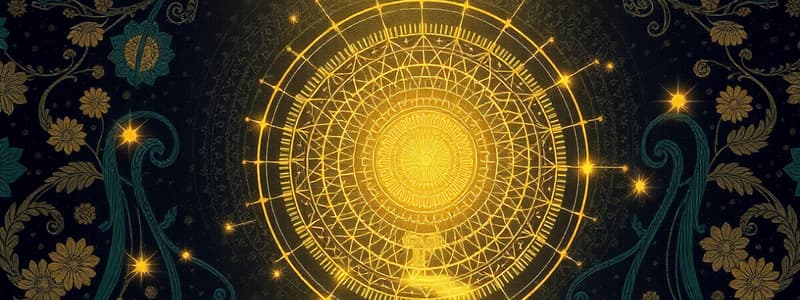Podcast
Questions and Answers
What is the formula for the magnetic flux ($\Phi_B$) through a surface in the context of electromagnetic induction?
What is the formula for the magnetic flux ($\Phi_B$) through a surface in the context of electromagnetic induction?
- $\Phi_B = BA \cos(\theta)$ (correct)
- $\Phi_B = B \cdot A$
- $\Phi_B = N \cdot I$
- $\Phi_B = \frac{1}{L} I^2$
In a resonant $RLC$ circuit, what is the expression for the resonant frequency ($\omega_0$)?
In a resonant $RLC$ circuit, what is the expression for the resonant frequency ($\omega_0$)?
- $\omega_0 = LC$
- $\omega_0 = \frac{1}{\sqrt{LC}}$ (correct)
- $\omega_0 = \frac{1}{R \cdot L}$
- $\omega_0 = R \cdot C$
What does the impedance ($Z$) in a series $RLC$ circuit simplify to at resonance?
What does the impedance ($Z$) in a series $RLC$ circuit simplify to at resonance?
- $Z = R$ (correct)
- $Z = L + C$
- $Z = 2R$
- $Z = R + j(\omega L - \frac{1}{\omega C})$
Which equation represents the relationship between refractive indices and the angle of incidence for light at the boundary of two mediums?
Which equation represents the relationship between refractive indices and the angle of incidence for light at the boundary of two mediums?
When dealing with self-inductance, what is the relationship between the inductance ($L$) and the current ($I$) through an inductor?
When dealing with self-inductance, what is the relationship between the inductance ($L$) and the current ($I$) through an inductor?
What causes the diffraction of light waves?
What causes the diffraction of light waves?
In the context of lenses, what does the magnification ($M$) express?
In the context of lenses, what does the magnification ($M$) express?
Which formula expresses the relationship between the reactance of a capacitor ($X_C$) and its capacitance ($C$)?
Which formula expresses the relationship between the reactance of a capacitor ($X_C$) and its capacitance ($C$)?
Explain how the energy stored in an inductor can be expressed mathematically, using the relevant variables.
Explain how the energy stored in an inductor can be expressed mathematically, using the relevant variables.
What physical phenomenon occurs when alternating current flows through a series RLC circuit at its resonant frequency?
What physical phenomenon occurs when alternating current flows through a series RLC circuit at its resonant frequency?
Describe the significance of total internal reflection in lenses and its practical implications.
Describe the significance of total internal reflection in lenses and its practical implications.
In the context of light waves, what role do interference patterns play in determining light's wave properties?
In the context of light waves, what role do interference patterns play in determining light's wave properties?
What is the relationship between frequency and wavelengths of light, and how does it affect the refraction angle?
What is the relationship between frequency and wavelengths of light, and how does it affect the refraction angle?
Explain how the concept of self-induction can impact the operation of an inductor in a circuit.
Explain how the concept of self-induction can impact the operation of an inductor in a circuit.
What is the impact of inductive reactance on the phase difference between voltage and current in an AC circuit?
What is the impact of inductive reactance on the phase difference between voltage and current in an AC circuit?
How does the magnification of a lens relate to its focal length and the distance of the object from the lens?
How does the magnification of a lens relate to its focal length and the distance of the object from the lens?
Study Notes
Electromagnetic Induction, Self-Induction
- Electromagnetic induction involves the production of an electromotive force (EMF) in a conductor due to a changing magnetic flux.
- The induced EMF is directly proportional to the rate of change of magnetic flux.
- Faraday's law: EMF = -N(dΦB/dt), where N is the number of turns in a coil and ΦB is the magnetic flux.
- The minus sign indicates Lenz's law, which states that the induced current opposes the change in magnetic flux.
Self-Induction
- Self-induction occurs when a changing current in a conductor creates a changing magnetic field that induces an EMF in the same conductor.
- The inductance (L) of a coil is a measure of its ability to oppose changes in current.
- The unit of inductance is the Henry (H).
- The induced EMF due to self-induction is given by: EMF = -L(dI/dt).
Energy Stored in an Inductor
- An inductor stores energy in its magnetic field.
- The energy stored in an inductor is given by: U = (1/2)LI².
Series RLC Circuit
- A series RLC circuit contains a resistor, an inductor, and a capacitor connected in series.
- The impedance (Z) of a series RLC circuit is the total opposition to current flow and is determined by the resistance (R), inductive reactance (XL), and capacitive reactance (XC).
- Impedance is calculated using the formula: Z = √(R² + (XL - XC)²)
- The resonance frequency (ωo) is the frequency at which the inductive reactance and capacitive reactance are equal, resulting in a minimum impedance.
- At resonance, the current in the circuit is maximum.
- The resonance frequency is calculated using: ωo = 1/√(LC).
Spherical Mirrors and Lenses
- Light rays can be reflected or refracted by spherical mirrors and lenses.
- Spherical mirrors are curved reflective surfaces, while lenses are transparent objects that refract light.
- The focal length (f) of a mirror or lens is the distance from the mirror or lens to the point where parallel rays converge or appear to converge.
- The magnification (M) of a mirror or lens is a measure of how much larger or smaller an image is compared to the object.
- Magnification is calculated using: M = - (image height)/(object height) = -(image distance)/(object distance).
Interference and Diffraction of Light
- Interference occurs when two or more waves overlap.
- Constructive interference occurs when the waves are in phase and reinforce each other.
- Destructive interference occurs when the waves are out of phase and cancel each other.
- Diffraction is the spreading of waves as they pass through an opening or around an obstacle.
- The amount of diffraction is determined by the wavelength of the light and the size of the opening or obstacle.
Studying That Suits You
Use AI to generate personalized quizzes and flashcards to suit your learning preferences.
Related Documents
Description
This quiz covers the principles of electromagnetic induction and self-induction, including Faraday's law and Lenz's law. Test your understanding of how changing magnetic fields can induce electromotive forces in conductors and the concept of inductance. Additionally, explore the energy stored in inductors.




